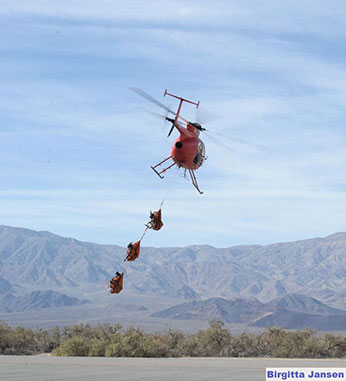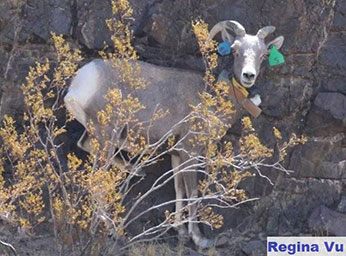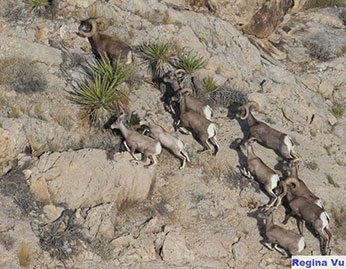
The helicopter capture crew returns 3 bighorn to their capture locations. Photo by Birgitta Jansen.
CDFW considers the monitoring of desert bighorn populations at both the herd and metapopulation levels essential for management. Individual herds are monitored by collecting data on population size, recruitment, survival, movement, and herd health; whereas the metapopulation is monitored by documenting extinctions, colonizations, range connectivity, and gene flow.
The overarching management goals for desert bighorn in California are outlined in CDFW’s Desert Bighorn Management Plan (under review). Long term goals for the individual management units are being outlined in range-specific documents.
Due to limited personnel and a large geographic area, it is currently not possible for CDFW to monitor all occupied and unoccupied mountain ranges. Consequently, there are different intensity levels of population monitoring: occupancy (presence/absence), rotational (data collected every 3-7 years), biennial, and annual.
The annual and biennial population monitoring efforts are targeted at current hunt zones, potential hunt zones, and other ranges that are considered critical to the connectivity of a region. The ranges that are surveyed annually are considered “core index populations” and are chosen as potential representatives of the ranges around them. If a major change is detected within a population then additional efforts will be directed to the surrounding populations to investigate the potential of a region-wide phenomenon, and to attempt to identify and/or address the cause. Other ranges that are known to have bighorn, but are not currently prioritized to be surveyed annually, or biennially, are scheduled to be surveyed via ground, helicopter, or camera every 3-7 years. Finally, ranges that are believed to be extirpated will be checked every 3-7 years for signs of occupancy.
All ranges are subject to shifts between different intensity levels of population monitoring.
Individual bighorn sheep are monitored using global positioning system (GPS) and very high frequency (VHF) collars. In addition, CDFW conducts walking-ground surveys, helicopter surveys, cameras surveys at water sources in the hot season, and they systematically collect fecal samples for genotyping.
Capture Methods

A ewe with eartags for individual markings and collars for tracking. CDFW photo by Regina Vu.
Bighorn sheep are captured by experienced helicopter capture specialists using a net gun fired from the helicopter at close range. After firing the net, one or two crew members exit the aircraft and restrain the sheep. No chemical immobilization is required for this technique. Captured bighorn sheep are then either processed in the field or transported via helicopter to a base camp, where biologists, veterinarians, and other CDFW crew members are waiting.
During processing, blood is collected to be assayed for trace minerals and tested for a variety of disease pathogens and exposure to those pathogens. Age is estimated by horn rings and tooth replacement. Nasal swabs, hair, and fecal samples are also collected. Samples are processed by the CDFW Wildlife Investigations Lab (WIL). For animals processed at base camp, morphometric measurements are recorded and ultrasonography is used to measure fat and determine pregnancy. A CDFW veterinarian is present at base camp to ensure the health of each individual and to attend to any injuries or concerns.
Given the risk of pneumonia in the desert bighorn populations, some of the most important samples collected during captures are for disease testing. Disease testing includes serologic testing for the following antibodies: bluetongue virus, bovine herpes virus, bovine respiratory syncytial virus (BRSV), border disease virus, contagious ecthyma, epizootic hemorrhagic disease virus, parainfluenza virus 3 (PI-3), and Mycoplasma ovipneumoniae (M. ovi.). The latter, M. ovi., is the primary suspect behind the 2013 pneumonia outbreak as well as countless other outbreaks that are ongoing in bighorn populations throughout the western states (WAFWA Wild Sheep Working Group).
Captured bighorn sheep are fitted with VHF and GPS collars and all bighorn are marked with numbered and colored ear tags (see photo). After handling is complete, bighorn sheep are transported via helicopter to their initial capture location and the capture crew releases the animal. The handling of each animal, from capture to release, takes approximately 60 minutes.
Population Surveys

Desert bighorn seen from above. CDFW photo by Regina Vu.
Walking ground surveys are conducted by a group of trained observers hiking through bighorn habitat in a mountain range over the course of one to several days. Observers work in teams of 1-3 and are equipped with spotting scopes, binoculars, and a map of their survey route. Each team also carries a radio or cell phone to communicate with other teams to avoid double counting and to aid one another in classifying and counting sheep visible to multiple groups. Bighorn groups seen by more than one team are recorded but later identified and removed from the data to produce a minimum count. In addition to developing a minimum count, these ground surveys also provide data on population composition, notably lamb to ewe, yearling to ewe, and ram to ewe ratios.
These surveys are usually conducted without the use of telemetry which allows the development of a mark-resight population estimate using the number marked sheep recorded during the survey. Mark-resight estimates use the proportion of animals seen that are collared, together with the total number of animals that are seen, and the total number of collars in the population, to estimate total population size. To meet the assumptions for a mark-resight survey, it is important not to use telemetry so that collared and uncollared animals have an equal chance of being observed. Individuals are identified by their unique ear tag and collar color combinations.
Ground surveys are designed to sample ewe groups, with survey routes tending to follow ridgelines from which the most ewe habitat could be seen. The number of rams recorded during ground surveys are likely under-representations because rams tend to range over larger areas not included in the survey. This habitat segregation, coupled with the fact that more ewes are marked during captures, is why mark-resight population estimates are calculated only for ewes. Monitoring focuses on ewes because they drive population dynamics.
Helicopter surveys became one of the main methods for monitoring desert bighorn populations in California during the early 1980s. Due to the rugged terrain that bighorn tend to inhabit and the limited ground access to many ranges, helicopter surveys have proven to be a useful sampling method. Helicopter surveys are conducted with four people: pilot (front right), data recorder (front left), photographer (rear right), and observer (rear left). Surveys are flown over typical desert bighorn habitat within predetermined polygons designed to be representative of habitat across the range.
To estimate a population within an area surveyed by helicopter, CDFW uses the simultaneous double-count methodology described by Graham and Bell (1989). In this method, all four people in the helicopter are independent observers and wait until an observed group of sheep has passed beyond the midway horizontal axis of the helicopter (directions 3 o’clock and 9 o’clock) before “calling” a group of sheep. The data recorder then marks which of the four observers made independent observations of the group before it was called. This method allows for a sight-ability estimate to be calculated for each range. The observations from the left side observers are used in this analysis. The resulting bighorn estimate is the predicted number of bighorn that were present within the area flown, given the sight-ability of that range.
Waterhole Sits and Cameras
During the hot summer months, CDFW uses waterhole sits and automated game-cameras to monitor desert bighorn. In some cases, if enough marked animals are present or natural marks can be identified, these data are used to estimate population size through mark-resight analyses. Camera data also provides information on population composition (lamb to ewe and ram to ewe ratios), disease presence (snotty noses or coughing), behavior, and overall body condition.
Waterhole sits consist of one or more observers sitting in a discrete location that allows them to watch bighorn approach and leave a water source. Waterhole sits tend to be most productive after a series of 3-5 hot (>105°F) days and at least a week after the last rainfall. From a vantage point, the observers record the time and group composition (sex, age, marked) of all the bighorn sheep that are within view. Waterhole sits are usually for a period of 4 hours and the results are primarily used to confirm lamb to ewe ratios and to monitor lamb health for signs of respiratory disease.
Automated trail cameras are used to complement and verify data collected by other methods. For CDFW purposes, cameras are strategically positioned at point-source water in an attempt to capture every individual that comes in to drink. Lighting, camera angles, and crowding of bighorn around water sources often make a mark-resight analysis difficult. Although photo analyses are time-intensive, cameras can successfully determine use of a water source, population composition, and general health of the animals.
Through CDFW's monitoring efforts, we have learned much about the population status of bighorn herds.